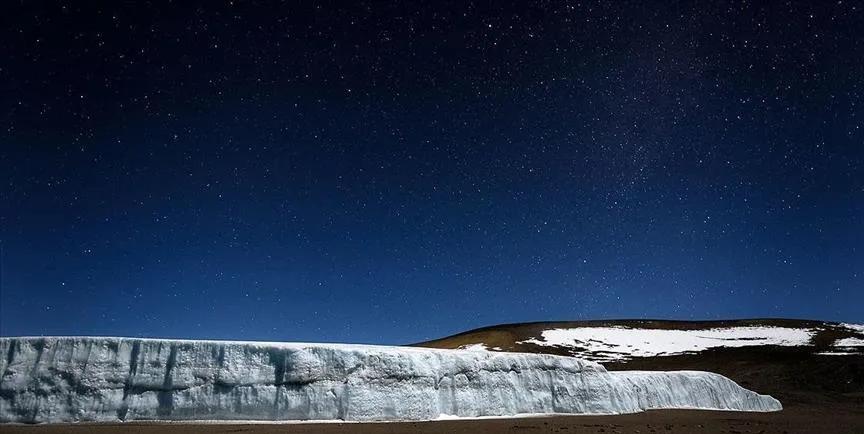Water is the source of life ~ Most of the freshwater resources on the earth are provided by glaciers and groundwater, followed by wetlands, lakes, and rivers, but since the last century, the global climate has warmed, glaciers have melted faster, and glaciers in many places have completely disappeared.

On October 19, the United Nations released an updated report from the World Meteorological Organization, which predicts that, based on the current global climate situation, Mount Kenya, Mount Tanzania-Kilimanjaro and Mount Uganda-Ruvenzori, all glaciers on these three mountains, will completely disappear by 2040. On the entire African continent, only these three peaks are covered by glaciers. They are not only an important water resource for people and animals in most parts of East Africa, but also a symbol of the beliefs and cultures of the people of East Africa for generations.
The disappearance of faith
Many people may not know that for the people of Kenya, Mount Kenya is a symbol of holiness and respect, and even the country is named after this mountain. Jomo Kenyatta, the first president of independent Kenya, wrote a book, Facing Mount Kenya. In the book, he describes in detail the culture and traditions of the Kikuyu tribe at the foot of Mount Kenya.
Legend has it that the creator god of the world, Engai (swahili means the allocator), resides at the summit of Mount Kenya and provides water and food for the animals and plants of the Kikuyu people and the Lekipia region below the mountain, while the reflection of the glaciers on Mount Kenya is considered by the Kikuyu people to be the shining palace of the god Engai. Now that the glaciers have melted, the luster of Kenya's mountain peaks has deteriorated day by day, and many elders in the tribe believe that the gods are angry and have left them. For them, this is not only the reduction of resources for survival, but also the disappearance of faith inheritance.
The same is true of Mount Kilimanjaro, sacred in the hearts of the Tanzanian people, and Mount Rwenzori, known as the "Moon Mountain" in the hearts of the Ugandan people.
The source of life
The decline in glaciers in Mount Kenya is also a looming threat to the local population's water supply. The rapidly falling water level directly threatens the 2 million Kenyans who rely on glacial rivers, and the Kenya Mountain Forest, located at the foot of Mount Kenya, is Kenya's most important freshwater resource reservoir, meeting 50% of the country's freshwater supply and 70% of hydroelectric power. At the end of the 19th century, UN Environment had calculated that there were 18 glacier belts in Mount Kenya, but now only 10 remain, and these 10 glaciers cover only one-third of the previous one.
Mount Kenya Glacier is the main water supply area of Kenya's two largest rivers: the Tana River and the north of the Ivasonuro River. The latter is the main source of water in the arid regions of northern Kenya. The reduction of glaciers is undoubtedly catastrophic for the people, animals and plants that live downstream. The crumbling land of thirst has caused tens of thousands of Kenyans to travel thousands of miles every day to fetch water, and many animals have died of thirst.
Not only that, but the influence of Mount Kilimanjaro and Mount Rwenzori on the surrounding areas has increased unabated. The demise of Mount Kilimanjaro's glaciers, one of Tanzania's largest rivers, the Pangani River, will devastate 13,000 hectares of forest vegetation in the region, which is equivalent to directly cutting off 1 million people from drinking water for a year. The demise of the Glacier of Mount Rwenzori will also cause irreversible damage to the virgin forest, flora and fauna and the waterfalls of the lakes and waterfalls downstream in the Rwenzori National Park.
As the highest peak in Africa and the largest independent mountain in the world, Kilimanjaro not only means a mountain, but also a pilgrimage to Africa, attracting more than 35,000 climbers every year. A copy of "The Snow of Kilimanjaro" has also become the original African image in the hearts of many people, but all this will end in 2040 and become a part of the long river of history forever.
The importance of glaciers
Glaciers are actually natural ice bodies that have existed on the surface of the earth for many years in polar or alpine regions and have a state of motion along the ground. Often referred to as "glaciers", glaciers are formed by years of snow accumulation, compaction, recrystallization, and re-freezing. It has a certain form and level, the glacier provides pure fresh water, its purity allows us to avoid a lot of toxins and mineral interference, is the most important freshwater resource on the surface.
It can be said that glaciers are the cornerstone of life on Earth, whether as drinking, irrigation or the production of hydroelectric power, they are the most valuable reservoir of fresh water, they support the earth's life system, affecting our daily lives, even if it is miles away from it.
However, as the most intelligent creature on the planet, human beings still appear incomparably small and helpless in the face of nature, we cannot prevent the demise of glaciers, nor can we predict the impact and changes on animals and plants after the demise of glaciers, we can only grasp the present, advocate low-carbon life and natural healthy lifestyle, and make a little contribution to global climate warming.
Maybe in 20 years, we will never see the snow of Kilimanjaro, the temple of Mount Kenya, the moonlight of Mount Ruwenzori.